Calorie content of radish and useful properties for the human body
Radish is one of the most popular root crops that grows in almost any climatic zone. A natural antioxidant, it is rich in nutrients, which makes it an indispensable product for those who care about their health and beauty.
In the article, we will consider what the calorie content of radish is (per 100 grams of product), kbzh, the amount of carbohydrates and other important characteristics of the root crop.
The content of the article
- Chemical composition and trace elements
- Nutritional value and BJU of radish
- What vitamins are contained in radishes
- Useful properties for the human body
- Slimming application
- Application in traditional medicine
- In the treatment of varicose veins
- When treating frostbite
- In the treatment of leukoderma
- Increased hemoglobin
- Elimination of symptoms of atherosclerosis
- Hepatic burning
- Insect bites
- Colds and flu
- Urolithiasis disease
- Bronchial asthma
- Improving the digestive tract
- Elimination of oily skin
- Elimination of inflammation on the face
- Nourishing mask
- Harm and contraindications to the use of radish
- Conclusion
Chemical composition and trace elements
Red radish contains a large amount of minerals that heal and cleanse the body. Wherein low calorie content allows you to use the product practically without restrictions.
| Fresh radish | Canned | Frozen | Tops | |
| Potassium | 233 | 333 | 230 | 270 |
| Sodium | 39 | 789 | 30 | 120 |
| Calcium | 25 | 28 | 23 | 30 |
| Phosphorus | 20 | 31 | 15 | 27 |
| Magnesium | 10 | 8 | 9 | 13 |
| Iron | 0,34 | 0,23 | 0,23 | 0,42 |
| Zinc | 0,28 | 0,22 | 0,25 | 0,34 |
The composition of the elements in ready-made meals depends on which additional ingredients were used in the preparation, and on the intensity and method of processing them. Most of the nutrients are found in fresh salads.
Attention! The data on the chemical composition may vary depending on the type of radish and the place of its growth, on the quality of soil saturation with mineral substances.
Nutritional value and BJU of radish
Often women wonder how many calories are in a radish.
100 g of red radish contains only 19 kcalmaking it dietary and suitable for fasting. In the composition of the root vegetable for every 100 g - 1.2 g of proteins, 0.1 g of fat and 3.4 g of carbohydrates.
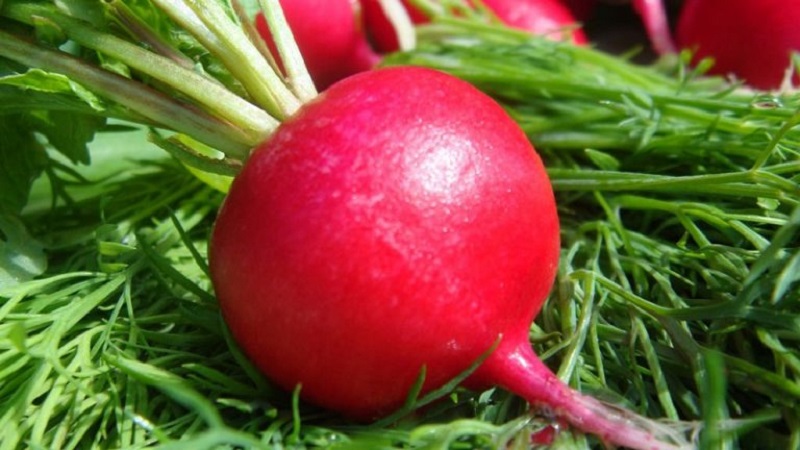
What vitamins are contained in radishes
In the composition of the root crop, in addition to the high content of minerals, it is noted high vitamins C, PP, group B. Mustard oil, which gives the vegetable a tart taste, increases appetite and has a positive effect on the absorption of vitamin C.
It is most useful to eat the tops of a young plant... It contains several times more vitamins, while their assimilation is faster and in greater quantities. For use, you should choose small leaves without damage.
Attention! The radish tops have the same pronounced taste as the root vegetable itself. It can be added to borscht, soups, fresh salads and dressings for meat dishes.
Useful properties for the human body
Root vegetable not only enriches the body useful substances, normalizing the vitamin and mineral balance in humans, but in general, it has a beneficial effect on the work of internal organs.
Due to its use occurs:
 strengthening of the walls of blood vessels and capillaries;
strengthening of the walls of blood vessels and capillaries;- improving the functioning of the digestive tract and cardiovascular system;
- increased absorption of vitamin C;
- elimination of toxins and toxic substances from the body;
- acceleration of cell renewal, which helps to prolong youth;
- reduction of the inflammatory process at the initial stages of its development;
- reducing the risk of developing cancer, especially in the digestive tract, mouth and liver;
- lowering blood cholesterol levels;
- normalization of the nervous system;
- prevention of constipation and increased intestinal peristalsis;
- prevention of blood clots;
- normalization of blood sugar levels;
- improving the condition of the skin, including in the presence of rashes;
- increased excretion of fluid from the body, which has a beneficial effect on the heart and kidneys;
- improving dental and oral health.
remember, that radishes are beneficial only if consumed in moderation... It is not recommended to exceed the daily allowance of 300 g.
Slimming application
Radish is a low-calorie vegetable that is consistently included in weight loss diets... But you can't eat it uncontrollably, especially to make mono diets out of it. Excessive absorption of radish threatens with serious disturbances in the digestive tract, the appearance of kidney and liver diseases.
To to reduce body weight, in combination with other useful products and physical activity it is recommended to eat 4-6 servings of salad with red radish per week. For better assimilation, the vegetable is combined with green salad, apples, celery and dill.
Such combining a remedy has a beneficial effect on the work of the heart and allows these salads to be included in diets for the treatment of high blood pressure. To get the maximum effect, it is additionally recommended to consume plenty of liquid.
Application in traditional medicine
Radish helps in the treatment of a number of serious medical conditions. When used correctly, it relieves puffiness and increases muscle tone. They are used in the treatment not only of fruits, but also tops.
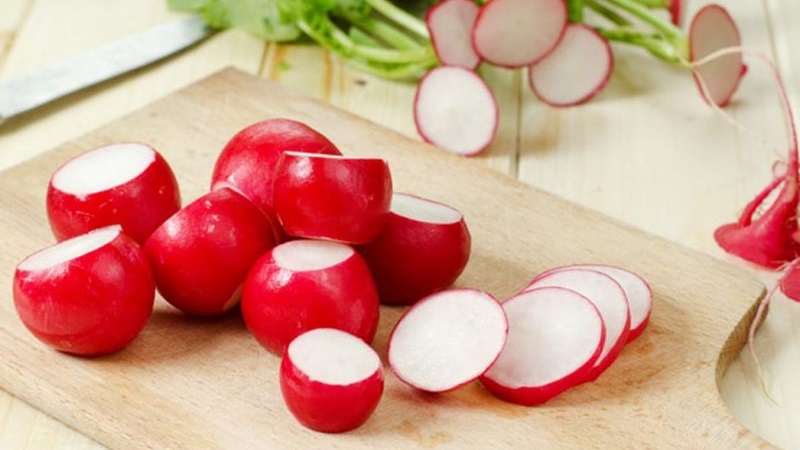
In the treatment of varicose veins
Several heads of radish are ground into gruel... Then it is mixed with a little lemon juice.
The product is rubbed with gentle massage movements 1-3 times a day into the affected areas of the legs. It is recommended to continue therapy for three weeks, after which a break for a month is required. Radiculitis and neuralgia are treated in the same way.
When treating frostbite
Only mild injuries can be treated this way.... To do this, mix radish gruel and hot water in equal amounts. After that, the resulting mass is placed in sterile gauze and applied to the affected area. Keep the compress for no more than five minutes. If necessary, repeat the procedure after 30-60 minutes.
In the treatment of leukoderma
To even out skin color requires cut the radishes into small slices and dip them in vinegar or ginger juice. After that, the slices of the root crop are applied to the affected areas for 15 minutes. If the radish burns strongly, it is removed and the skin is washed well. Treatment continues for three weeks with a monthly break.
Increased hemoglobin
To prepare the tincture, take a small glass container made of dark glass. They add to it 50 g of dried radish and mixed with 100 ml of quality vodka... The bottle is tightly corked and insisted for two weeks. It is impossible for the container to be exposed to direct sunlight. Take a 20 ml remedy one hour before bedtime for four weeks.
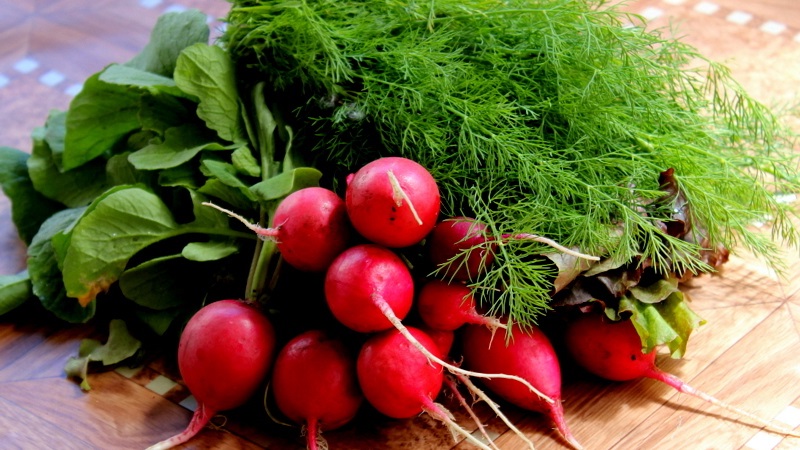
Elimination of symptoms of atherosclerosis
In this case, young leaves of the plant are used.... The tops are thoroughly crushed and mixed in equal proportions with natural honey. Take the remedy daily for a month for 2 tsp. Between courses take a break of 2-4 weeks.
Hepatic burning
To eliminate an unpleasant symptom, take 3-4 leaves of young tops and pour 200 ml of boiling water. After 15 minutes, you can add 1-2 tablespoons of sugar to the resulting tea and drink it in small sips. Up to three servings of the drink are drunk a day. Do not continue therapy for more than a week.
Insect bites
To eliminate itching and inflammation, fresh juice is squeezed out of the vegetable and abundantly moisten the affected area with it. The procedure is repeated several times a day until the unpleasant symptoms disappear completely.
Take a note:
Radish for the winter: simple and delicious recipes for healthy snacks
The best pickled radish recipes for the winter
Harvesting radishes for the winter by freezing and in other ways
Colds and flu
For treatment, mix the juice of onion and radish in equal proportions... Natural honey is melted in a water bath and added to juices in a ratio of 1 to 1. It is required to take such a product 2-3 times a day, 20 ml for 3-5 days.
Urolithiasis disease
For small stones, the juice from beets and radishes helps the process of removing them.... 100 ml of beetroot juice requires 20 ml of radish juice. The medicine should be taken after breakfast for 5-10 days.
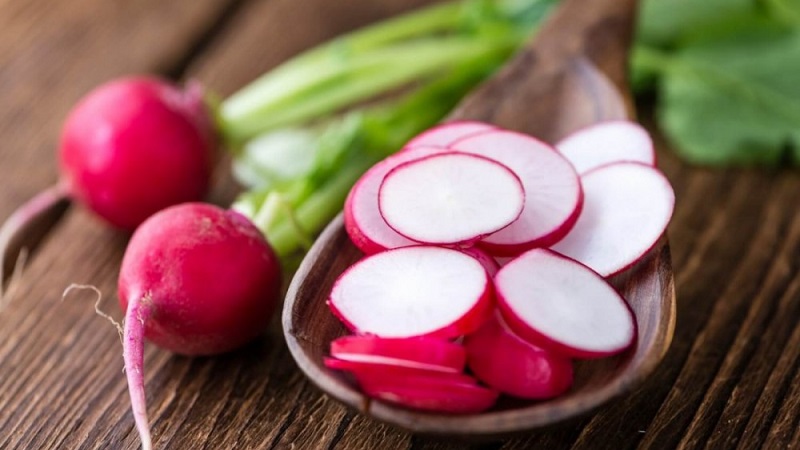
Bronchial asthma
During an exacerbation of the disease, you will need to mix 100 ml of radish juice and 20 ml of honey, preheated in a water bath. Take the resulting remedy for 2 tsp until it is possible to stabilize the general condition of the patient.
Improving the digestive tract
Thoroughly chop 5-6 radish heads and mix them with 2 g of starch. Then add 200 ml of warm milk to the mixture and mix well. The resulting product is drunk 30 minutes before breakfast for a month.
Elimination of oily skin
5-7 small heads of radish are mixed with 50 ml of warm milk, finely chopping the whole mass in a blender. The mask is applied to cleansed skin for 15-30 minutes weekly.
Elimination of inflammation on the face
Chopped radish (20 g) is mixed with 2.5 ml of melted honey and the same amount of calendula tincture. The agent is applied strictly to the site of inflammation, leaving it for 30 minutes. After the treatment, a soothing cream is applied to the face.
Nourishing mask
Chopped tops (50 g) are combined with 10 ml olive oil and a teaspoon of starch. The resulting mass is applied to the face, avoiding the area around the mouth and eyes. Keep the product for 5-10 minutes. A nourishing mask can be done 1-2 times a week.
Attention! Despite the pronounced useful and medicinal properties of radish, in the presence of serious chronic disorders, it is recommended to include the root vegetable in combination therapy with traditional medicines.
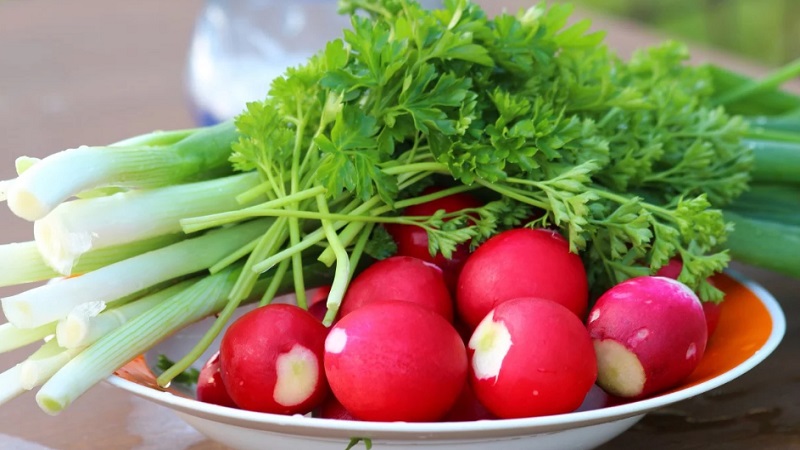
Harm and contraindications to the use of radish
The root vegetable has pronounced antiseptic and bactericidal properties... But this feature made the radish dangerous for consumption in such cases:
- period of exacerbation of diseases of the digestive tract;
- inflammatory process in the thyroid gland;
- peptic ulcer and inflammation of the pancreas;
- goiter and hyper-assimilation of vitamins in the body;
- the presence of foci of gastritis on the gastrointestinal mucosa;
- period of exacerbation of kidney and liver diseases, including chronic ones;
- the recovery period after a heart attack.
In the presence of gastrointestinal diseases during the period of their remission, it is allowed to eat a small portion of radish... At the same time, it is recommended to choose varieties with a lower content of mustard oil. If a person has tachycardia, you should refrain from eating the root vegetable, since its essential oils increase blood flow and pulse.
Attention! In the presence of chronic disorders of the digestive tract, it is recommended to consult a gastroenterologist before consuming radishes.
Conclusion
Radish is a root vegetable that saturates the body with useful substances and allows you to maintain health. But before use, you should make sure that the product is fully tolerated so as not to harm the digestive tract and not provoke an exacerbation of chronic disorders.